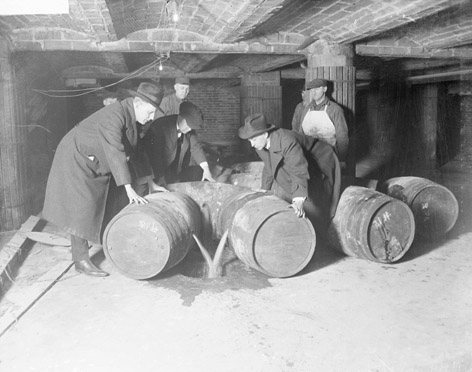
Public Domain (via Wikipedia)
On 16 January 1919, the 18th Amendment to the U. S. Constitution was formally ratified. Under the 18th Amendment, the manufacture and distribution of alcohol in the United States (outside of industrial and sacramental use) was prohibited beginning a year later on 17 January 1920. Congress passed the Volstead Act to provide teeth to the law by allowing for enforcement of this law by the federal government, specifically a special unit of the Treasury Department. President Wilson vetoed the Volstead Act but overrode by Congress.
In the 19th century, temperance movements arose to address the growing problem of families being damaged when a husband or relative became addicted to alcohol. Also it was a means of curtailing acts of public drunkenness and related problems with people gathering to drink (gambling, prostitution etc.) The movement, religiously based in many cases, gathered steam and became a political one where it campaigned the state level for abstinence laws. In December 1917 Congress passed the amendment and sent it to the states for ratification.
All but two states ratified, a few after it had met the requisite number needed to amend the Constitution. Connecticut and Rhode Island were the two that rejected the amendment. Minnesota, Nevada, New Jersey, New Mexico, New York, Pennsylvania, Vermont and Wisconsin all ratified after 17 Jan 1919.
Aftermath
Enforcement at national and state levels became an issue right away. Neither Canada or Mexico were dry and illegal importation was an issue. Also with Cuba 90 miles away from Florida, it would provide another avenue for rum and other alcohols to be smuggled in. Breweries switched to making non-alcoholic beverages during this time. Wineries could only produce wine for sacramental (religious use), so they too had to turn to things like grape juice or apple cider. The law was not popular in a lot of cities, resulting in the rise of illegal places (called speakeasies) where you could drink alcohol.
To meet this need, many organized crime syndicates and gangs would supply the alcohol either by owning their own breweries and/or smuggling it in from outside the country. These crime syndicates would become enormously wealthy and corrupt local governments (police, politicians, judges) in order to stay in business. Competing gangs would sometimes duke it out on the streets leaving bodies of their enemies (and sometimes the innocent as well). Chicago became particularly notorious, both for its gangs and the depth of corruption. This prompted the federal government to target the Chicago Gang run by Al Capone. While they would raid his operations (done by the famous Elliott Ness), the financial investigation would lead to a successful conviction of tax fraud.
By the end of the decade, support for Prohibition had ebbed considerably. The rise of the organized crime, the fact many flouted the laws in large and small ways, and the difficulties encountered in enforcing the law all led to is eventual demise. When the Great Depression hit in 1929, many argued the alcohol industry could provide jobs. Franklin Roosevelt added it to his campaign plank in 1932. In 1933, the U.S. Congress passed the 21st Amendment to repeal the 18th (the first such Amendment to do this) which was swiftly passed by most states. A few remained dry (under the provisions of the 21st Amendment, a state could decide to stay dry) after that but today states no longer ban its sale. There are still some counties that are dry, including the one where the Jim Beam distillery is located in Kentucky.
Sources:
“Prohibition Is Ratified by the States.” HISTORY, www.history.com/this-day-in-history/prohibition-ratified.
“Eighteenth Amendment | Definition, Summary, and Facts.” Encyclopedia Britannica, 16 Jan. 2024, www.britannica.com/topic/Eighteenth-Amendment.
“18th Amendment.” Constitution Annotated, constitution.congress.gov/constitution/amendment-18.
